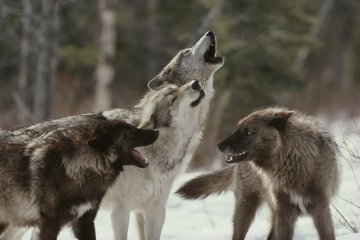Wolf Packs
 Wolves are considered to be extremely social. Most species choose to live in social units, called “packs,” that can be made of multiple female and male adults or, in some cases, only one female.
Wolves are considered to be extremely social. Most species choose to live in social units, called “packs,” that can be made of multiple female and male adults or, in some cases, only one female.
Social Relationships
As a form of social organization, wolf packs are usually family groups in which most members are related by a bloodline connection. The group is usually led by a pair of wolves – one male and one female.
This mated pair usually leads a group of six to seven members that can be pups or wolves that are up to three-year-old adults. In most cases, the members are the offspring of the Alpha male and the female. Sometimes, the groups can include as many as 15 or more members.
The Pack’s Social Habits
Regardless of the species, the packs are known to have some common behaviors. All of them have an Alpha male and members can be cast out at any time when the Alpha is contested. However, the members tend to follow their leadership above all else.
Hierarchy is one of the most important organizational structures in a pack. It is their main form of organization, but it is also a reason for members to fight each other. The packs will hunt as a group, stalk prey, and protect each other.
Gender Roles in a Pack
Roles are assigned to all members of the pack which is also an indicator of their behavior. Males express their superiority at an early age by bullying others. The Alpha male is usually the strongest and most of the times, the one that will mate with the female.
Females, on the other hand, tend to fight each other more often than males, thus making it uncommon to see more than one in a pack as in the end, the dominant one will banish the others.
Wolf Pack Mentality
In a pack, the first priority is stability and organized hunting. To some degree, the pack makes use of tactics and organized hunts. For example, when hunting a moose or an elk, they will stalk the prey and attack with the entire group.
If the prey ends up swimming in deep water, the pack will rest with the exception of two or three wolves that will continue to stalk the prey until it gets fatigued. Once the prey is captured, the Alpha male will be the one to eat first.
